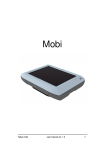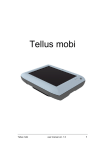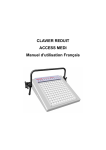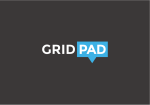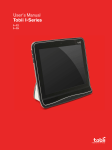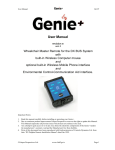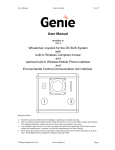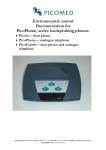Download GB Manual for Laser Pointer - Zygo
Transcript
GB Manual for Laser Pointer TABLE OF CONTENTS GB MANUAL FOR LASER POINTER .......................... 8 INTRODUCTION.................................................................................................... 8 FACTS ABOUT LASER LIGHT................................................................................ 8 How strong is the light in the Laser Pointer? ................................................ 8 ATTACHING THE LASER ...................................................................................... 9 Attachment Items ............................................................................................ 9 Spectacles ..................................................................................................... 10 Cap................................................................................................................ 10 Helmet........................................................................................................... 11 Headband ..................................................................................................... 11 CHARGING ........................................................................................................ 11 Indicator lamp and charge cycle.................................................................. 11 CLEANING ......................................................................................................... 11 DISPOSAL .......................................................................................................... 12 ACCOMPANYING ITEMS ..................................................................................... 12 TECHNICAL SPECIFICATIONS ............................................................................. 12 2 GB Manual for Laser Pointer Introduction The laser pointer is a communication aid for disabled people who are unable to communicate using speech, writing or other methods. It consists of a laser and a battery unit. The laser is attached to the user's spectacles, headband, cap, or similar. The laser emits a red point of light that is used to point at various objects in the user's surroundings, such as texts, symbols, pictures and objects. This makes it possible for a user with disabilities to communicate in a simple manner. The light point is highly concentrated, which makes it visible at a long distance, even in situations with a high ambient light level. Facts about Laser Light Laser light is classified based on the output power of the light. • Class 1 is laser light with an output power less than 0.4 µW. This light does not produce a visible point in normal room lighting and is considered to be completely safe. • Class 2 is laser light with an output power less than 1 mW. All lasers are approved for use as pointing devices in public situations, and they cannot damage skin. However, care shall be taken to avoid focusing the light source into the eye. How strong is the light in the Laser Pointer? The laser pointer is a Class 2 laser with an output power of <1mW. The laser pointer has been tested and approved by SP Technical Research Institute of Sweden according to standard EN-60825-1-2001 and CFR 1040.10-2005. Warning! The laser pointer is not a toy, but it may be tempting to play with it. Make sure t hat children do not play with the laser pointer, and ensure that children are kept under supervision when the laser pointer is being used. Never try to stare directly into the laser source! 8 The Parts of the Laser Pointer On/Off switch Battery unit Output for Laser Output for external control switch. On/Off switch Laser Clips for attachment to trouser lining Input for battery charger Indicator lamp for charging Battery charger Attaching the Laser There is no generally applicable method of attaching the laser to the user – an individual solution must be devised. Some different means of attachment that can be used are described below. These means of attachment are included with the laser. Attachment Items Plastic holder that is riveted in position. Used to attach the laser to a cap, for example. Plastic ties, used to attach the laser to spectacles. Self-adhesive plastic holders that can be opened. Can be combined with Velcro tape for attachment. Velcro tape 9 Spectacles If the user wears spectacles, the laser can be attached to their frame. If the user does not normally need spectacles, it is possible to try out using spectacles with plain glass, using them only when the laser pointer is to be used. The accompanying plastic ties are used to attach the laser to the frame. Plastic tape or rubber bands may also be used. Cap The laser can be attached to the peak of a cap, for example. It may be an alternative to use a cap with an open upper part, if a normal cap is too warm. Plastic holder riveted in place. Cable sewn in place. 10 Helmet The laser can be attached to a helmet if the user wears one. Use suitable attachment means in this case. Headband The laser can be attached to a headband. In this case, the laser will be positioned at the side of the head. This works well if the user can hold the head reasonably steady. Charging The laser pointer must be charged for at least two hours before it is used for the first time. This will ensure maximal lifetime for the batteries. It takes approximately 2.0 hours to charge the batteries. The charger switches to maintenance charging at the end of this period. Charge the pointer regularly, preferably during the night. The pointer can operate for up to 20 hours with a fully charged, new battery. Indicator lamp and charge cycle Indicator lamp Yellow Yellow Orange Green with intermittent yellow flash Green Alternating orange - green Mode Battery not connected Battery initialisation and analysis Fast charge Top-off charge Trickle charge Error Warning! Use only the accompanying rapid charger Mascot NiCd/NiMH charger Type 2115. Connection of an incorrect charger can result in the destruction of electronic circuits and batteries, and in the worst case, can cause fire. The laser pointer cannot be used while the unit is being charged. The laser pointer can be switched off with the switch or with the external control switch, in order to save battery power. Cleaning The laser and the electronics unit can be cleaned with a lightly dampened cloth. 11 Disposal The laser pointer contains nickel metal hydride batteries (NiMH). These batteries must be removed and disposed of in the proper manner for expired batteries, before disposal of the laser pointer. Other components are to be disposed of in the proper manner for electrical waste. Accompanying Items Art. no. 0406 0403 040510 ------------809070 Denomination Laser Battery unit Mascot NiCd/NiMH charger Type 2115 Plastic holders Openable plastic holders Velcro tape Ties User's manual Quantity 1 1 1 2 2 50 mm 10 1 Technical Specifications Type of battery charger: Current consumption: Type of chargeable batteries: Operating time with fully charged batteries: Laser dimensions: Electronics unit dimensions: Environmental conditions for use: Laser power: Laser class: Mascot NiCd/NiMH charger Type 2115 30 mA NiMH 3 x R6 1300 mAh (from serial no: 511730) Up to 20 hours of continuous use 54 x 10 mm 55 x 95 x 23 mm Indoor environment, dry <1mW 2 (up to 1 mW) Gewa AB BOX 92, SE-191 22 SOLLENTUNA, SWEDEN TEL: +46 (0)8-594 694 00 • TEXTTEL: +46 (0)8-594 694 18 • FAX: +46 (0)8-594 694 19 E-MAIL: [email protected] • WEB: www.gewa.se Art.no: 809070. Doc: LPEK9435 SE, GB. Ver: H. Date: 2007-05-31. 12









